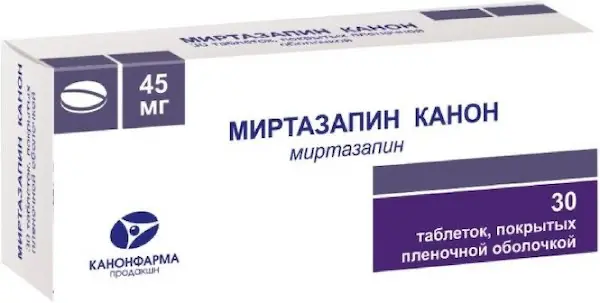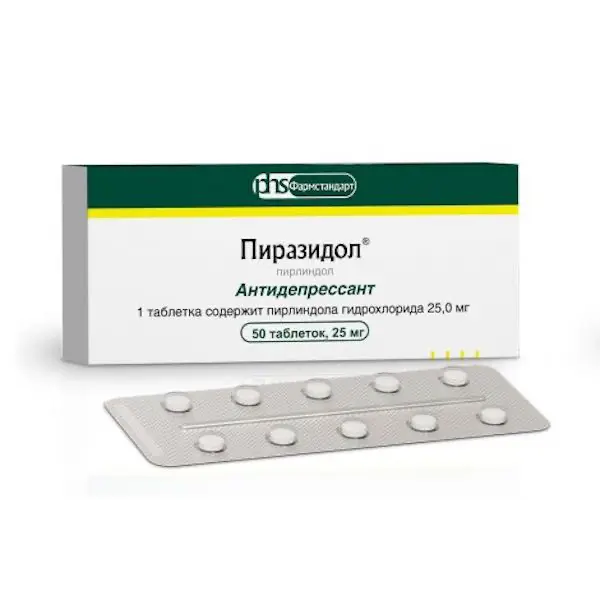Description
Mirtazapine-Canon Pharmacodynamics
Mirtazapine is an antidepressant of tetracyclic structure with predominantly sedative action. The drug is most effective in depressive states with clinical symptoms such as inability to experience pleasure and joy, loss of interest (anhedonia), psychomotor retardation, sleep disturbances (especially early awakenings) and weight loss, as well as other symptoms: suicidal thoughts and daily mood swings.
Antidepressant effect of the drug usually comes after 1-2 weeks of treatment.
Pharmacodynamics
Mirtazapine is an antagonist of presynaptic alpha2-adrenoreceptors in the central nervous system and increases central noradrenergic and serotonergic transmission of nerve impulses. At the same time, the enhancement of serotonergic transmission is realized only through 5-HT1-receptors, because mirtazapine blocks 5-HT2- and 5-HT3-receptors. Both enantiomers of mirtazapine are thought to have antidepressant activity, the S(+)-enantiomer blocking alpha2- and 5-HT2-receptors and the R(-)-enantiomer blocking 5-HT3-receptors.
The sedative properties of mirtazapine are due to its antagonistic activity toward H1-histamine receptors.
Mirtazapine is generally well tolerated. It has virtually no
m-cholin-blocking activity and has limited cardiovascular effects at therapeutic doses (e.g. orthostatic hypotension).
Indications
Depressive states (including anhedonia, psychomotor retardation, insomnia, early awakening, weight loss, loss of interest in life, suicidal thoughts and mood lability).
Contraindications
Hypersensitivity to mirtazapine or other drug components;
under 18 years of age (efficacy and safety have not been established);
concomitant use with monoamine oxidase inhibitors (MAOIs).
Caution
Correction of the dosage regimen and regular medical monitoring are necessary for the following patients:
Patients with epilepsy and organic brain lesions (against the background of therapy with the drug in rare cases, the development of seizures is possible);
Patients with hepatic or renal insufficiency;
patients with heart disease (conduction disorders, angina pectoris or recent myocardial infarction);
patients with cerebrovascular disease (including a history of ischemic attacks);
patients with arterial hypotension and conditions predisposing to hypotension (including dehydration and hypovolemia);
patients with drug abuse, drug dependence, mania, hypomania.
Like other antidepressants, mirtazapine should be used with caution in the following cases:
Urinary disorders, including prostatic hyperplasia;
acute closed-angle glaucoma and elevated intraocular pressure;
diabetes mellitus;
hyponatremia.
Pregnancy and breastfeeding period
The safety of mirtazapine use during pregnancy has not been established, therefore, Mirtazapine Canon should be prescribed during pregnancy only when the benefit to the mother exceeds the potential risk to the fetus; treatment should be carried out under medical supervision. The use of serotonin reuptake inhibitors in pregnancy, especially in the late stages, may increase the risk of neonatal persistent pulmonary hypertension.
It is not known whether mirtazapine is excreted with breast milk, so the use of Mirtazapine Canon during breastfeeding is not recommended.
Dosage and administration
- Tablets should be taken orally without chewing and with a small amount of water. Food intake has no effect on the pharmacokinetics of the drug.
- The half-life of mirtazapine is 20-40 hours and therefore the drug is suitable to be taken once a day. It is preferable to take the daily dose in one sitting, before going to bed at night. Mirtazapine can also be given twice a day by dividing the daily dose in half (morning and night).
- Treatment with Mirtazapine Canon should be continued if possible for 4-6 months until the symptoms have completely disappeared. After that the treatment may be gradually withdrawn. The drug begins to exert its effect after 1-2 weeks of treatment. Treatment with an adequate dose should lead to a positive response after 2-4 weeks. In case of insufficient response to treatment, the dose can be increased to the maximum dose (45 mg). If there is no response to treatment after another 2-4 weeks, treatment should be discontinued.
- Adults
The recommended initial daily dose is 15 mg/day or 30 mg/day, which is gradually increased if necessary to 45 mg/day. - Older adults
The recommended dose is the same as for adults. In elderly patients, in order to achieve a satisfactory and safe response to treatment, the dose should be increased under the direct supervision of a physician. - Patients with renal or hepatic impairment
In patients with renal or hepatic impairment, the clearance of mirtazapine may be reduced. This should be considered when prescribing the drug to this category of patients.





